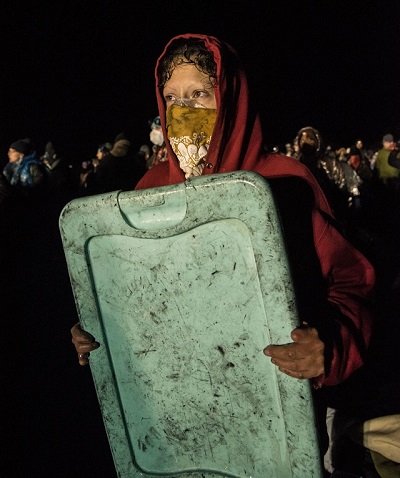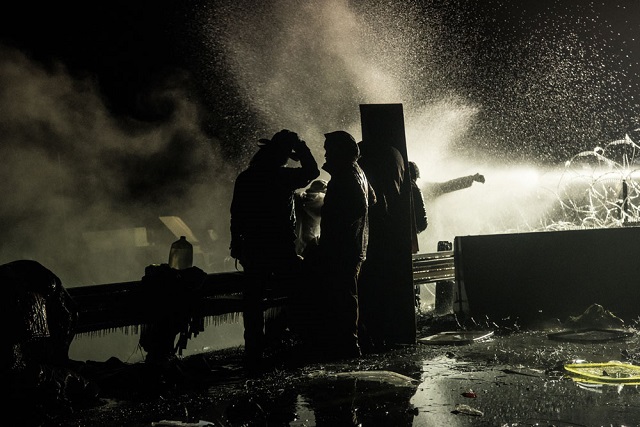
“If we hadn’t been there, Morton County Sheriff’s Department could have deaths on their hands.” – The medical staff at the Standing Rock camp of Oceti Sakowin.
On Sunday, November 20, a confrontation between police and Standing Rock Water Protectors escalated as police shot water cannons and rubber bullets into the crowd. The onslaught went hours into the night, and without showers or a nearby medical center, the residents of nearby Oceti Sakowin who were injured or exposed to hypothermia were vulnerable to permanent physical damage.
As the Standing Rock Medic and Healer Council noted in a press release, “approximately 300 injuries were identified, triaged, assessed and treated by our physicians, nurses, paramedics and integrative healers working in collaboration with local emergency response. At least 26 seriously injured people had to be evacuated by ambulance to three area hospitals.” Many of these injuries resulted from close range, direct hits from police projectiles.
Michael Peñuelas, who drove one of the three medical transport vans on that Sunday night, said these were some of the worst casualties he had seen in the conflict with DAPL workers and local police. “Law enforcement was using a lot of ‘less lethal ammunition.’ That included beanbag rounds; that included rubber bullets,” Peñuelas told Truthout. “A lot of people had been hit by those and had very serious contusions. I had a guy who had a lot of broken fingers; two people with very serious head injuries, bleeding like nobody’s business. One guy had a seizure as we were putting him in the back of the truck.”
According the the US Department of Defense, “reversibility is a ‘key attribute’ associated with all non-lethal weapons and refers to the ability to return the intended target to its original pre-engagement level of functionality. While non-lethal weapons are use-of-force weapons that may cause injury when used appropriately, the effects are intended to be reversible.” Any law enforcement officer in possession of less than lethal weaponry is required to go through extensive training and engage built-in safety constraints to prevent any “inappropriate use.” Rubber bullets, for instance, are designed not to be shot directly at close range, but to be aimed at the ground to hit the target’s legs, which may cause pain, but not serious injury.
 A Water Defender shields herself from rubber bullets and tear gas. (Photo by Avery L. White)Much of the worst damage was only reversible thanks to the hard work and organization of Oceti Sakowin’s extraordinary medical volunteers. Over the past few months, the medical area has expanded to accommodate the needs of the camp, as one woman who has been a central medical volunteer at the camp since September, testified: “We went from two medics in a tent, to a full coverage medical village. We now have medics with combat experience, intensive care experience, herbalists, naturopaths, body workers, reiki specialists and midwives — where else can you get that kind of complete care?” Not only does the medical village serve the needs of the residents of Oceti Sakowin, but they also offer care free of charge to the medically underserved surrounding community. “A lot of people from outside camp have come for treatment, especially when it comes to prenatal care,” she said. The health center has also been kept well-stocked with everything from simple first-aid supplies to handmade herbal remedies from donations by supporters of the Water Protectors from all over the country.
A Water Defender shields herself from rubber bullets and tear gas. (Photo by Avery L. White)Much of the worst damage was only reversible thanks to the hard work and organization of Oceti Sakowin’s extraordinary medical volunteers. Over the past few months, the medical area has expanded to accommodate the needs of the camp, as one woman who has been a central medical volunteer at the camp since September, testified: “We went from two medics in a tent, to a full coverage medical village. We now have medics with combat experience, intensive care experience, herbalists, naturopaths, body workers, reiki specialists and midwives — where else can you get that kind of complete care?” Not only does the medical village serve the needs of the residents of Oceti Sakowin, but they also offer care free of charge to the medically underserved surrounding community. “A lot of people from outside camp have come for treatment, especially when it comes to prenatal care,” she said. The health center has also been kept well-stocked with everything from simple first-aid supplies to handmade herbal remedies from donations by supporters of the Water Protectors from all over the country.
Following the attack, there is a chance that without such a well-run health facility, some of the severest injuries could have become fatalities, as Dr. Jasmine Wiley, a volunteer on the scene reported. “There was an elder Vietnam vet who was at the front line who was pulseless and non-breathing. One of our EMS personnel volunteers started to do chest compressions and he was revived at the scene. I spent an hour plus with him and one of our mental health providers in the back of a pickup trying to get him stable. He had been shot in the chest and back with one of the devices, either a rubber bullet or concussion grenade.”
With the nearest hospital an hour away from the scene, it was left to the medical center to act as first responders and emergency transport. “We had upwards of 500 people who had hypothermia or borderline hypothermia from use of water cannons in 22-degree weather,” said Michael Knudsen, a medical logistics coordinator for the Standing Rock Medic and Healer Council. “If we hadn’t been there, Morton County Sheriff’s Department could have deaths on their hands.”
Vanessa Bolin, a Native medic coordinator, confirmed that without immediate attention from medical professionals, some of those hardest hit might not have survived. “In addition to the cardiac arrest, we saw a seizure where the patient’s airway closed that we had to manage by manually clearing the airway,” Bolin said. “Without trained medics here there would have been possibly two deaths.”
 Water Protectors surrounded by tear gas, water cannons and rubber bullets. (Photo by Avery L. White)
Water Protectors surrounded by tear gas, water cannons and rubber bullets. (Photo by Avery L. White)
We have 10 days to raise $50,000 — we’re counting on your support!
For those who care about justice, liberation and even the very survival of our species, we must remember our power to take action.
We won’t pretend it’s the only thing you can or should do, but one small step is to pitch in to support Truthout — as one of the last remaining truly independent, nonprofit, reader-funded news platforms, your gift will help keep the facts flowing freely.